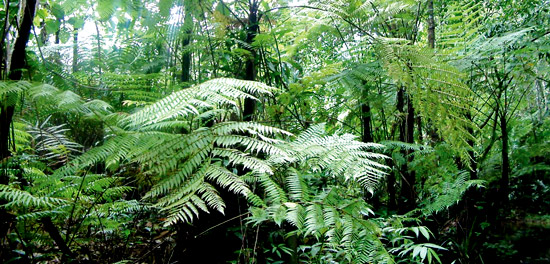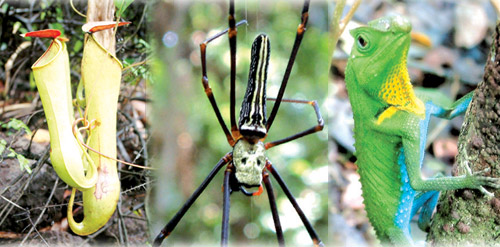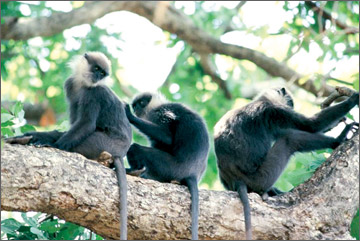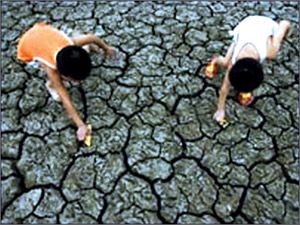|

Sinharaja's rich biodiversity
 It
is all about constructing a road through a land rich in amazing
bio-diversity. It has stirred a controversy as it runs through the
country’s precious lowland rain forest - Sinharaja. Undoubtedly road
development is an integral part of a country’s development but such
development projects need to be carried out after a careful study to
prevent harm to the existing bio-diversity. The latest road
construction, which designed to construct a road between Ilumbakanda and
Suriyakanda and created a tug-of-war between officials and
environmentalists, has been temporary halted until it gets the final nod
by the committee appointed by the Minister of Environment Anura
Priyadarshana Yapa. It
is all about constructing a road through a land rich in amazing
bio-diversity. It has stirred a controversy as it runs through the
country’s precious lowland rain forest - Sinharaja. Undoubtedly road
development is an integral part of a country’s development but such
development projects need to be carried out after a careful study to
prevent harm to the existing bio-diversity. The latest road
construction, which designed to construct a road between Ilumbakanda and
Suriyakanda and created a tug-of-war between officials and
environmentalists, has been temporary halted until it gets the final nod
by the committee appointed by the Minister of Environment Anura
Priyadarshana Yapa.
While state officials claim it was ‘just widening of a century-old
foot path to facilitate the villages’, conservationists claim that this
major project to connect Kalawana and Kolonne through Pothupitiya,
Illuokanda to Rakwana via Deniyaya A17 road near Suriyakanda, will
destroy a significant part of the forest patch adjoining to the Morning
Side of Sinharaja, which is home for many identified and non-identified
wealth of flora and fauna.If the authorities go ahead with road
construction, conservationists claim that a large portion of Sinharaja
which comes under the Land Reform Commission (LRC) would have a severe
impact on the unique ecosystem of the Morning Side of Sinharaja, which
is home to several threatened endemic species. Due to its uniqueness the
Sinharaja was declared a UNESCO World Heritage Site and a Man and
Biosphere Reserve.
 Here
is an attempt to explore the unique ecological value of the said forest
patch, which the authorities need to strike a balance between nature and
development as these ‘eco- wonders’ are no disappearing. The Sunday
Observer interviewed Sajeewa Chamikara of the Environment Conservation
Trust on the importance of preserving the unique bio-diversity. Here
is an attempt to explore the unique ecological value of the said forest
patch, which the authorities need to strike a balance between nature and
development as these ‘eco- wonders’ are no disappearing. The Sunday
Observer interviewed Sajeewa Chamikara of the Environment Conservation
Trust on the importance of preserving the unique bio-diversity.
The Singharaja Forest is a unique ecosystem. A span of 11,187
hectares of the Sinharaja Forest was declared a National Heritage
Wilderness Area under the National HeritageWilderness Area Act No. 04 of
1988. It comprises a canopy typical to the Tropical Wet Evergreen
Rainforests and three unique climax vegetation types: Hora community,
Na-Dun community, Milla-Diyapara-Hedawaka-Welipanna community. A unique
plant community composed of the two endemic species Rath dun (Shorea
gardneri) and Yakahalu (Shorea trapezifolla) exist in the Sinharaja
Estate and Enasal Estate owned by the State Plantation Corporation.
Four hundred and ninety five (495) of the 926 endemic flowering
plants of Sri Lanka as well as 13 of the 25 endemic plant Genera are
recorded from the Sinharaja Forest. Fifteen point endemic species of
flora occur in the forest while 340 woody plants are recorded, out of
which 192 are endemic to the country.
According to the records, 42 species of ferns are found in the
Singharaja forest. Ten of these species are endemic. Among the ferns
are, Pathrakoku (Cyathea crinita), Gini hota (Cyathea walkeri), Walmeda
(Angiopteris evecta), Barukoku (Blechnum orientale), Bird’s nest fern (Asplenium
nidus) and Mahahedaya (Huperzia phlegmaria) in addition to the smallest
fern species recorded from Sri Lanka, the epiphytic Microgonium motleyi.
More than 80 of the 189 orchid species from Sri Lanka grow in the
Singharaja forest. Some of the rare Endemic species of orchids are
Vanaraja (Anoectochilus setaceus), Iruraja (Zeuxine regia), Mahapadma (Podochilus
malabaricus), Kudapadma (Podochilus saxatilis), Jatamakuta (Flickingeria
macraei) and Wesakmal (Dendrobium maccarthiae) Nine species of rattan
are found while the total number of species known from Sri Lanka is ten.
Thambotuwel (Calamus zeylanicus), Thudarena (Calamus ovoideus), Narawel
(Calamus delicatulus), and Mawewel (Calamus thwaitesii) are among the
rare and endemic Calamus species in the Sinharaja Forest.
 The
endangered Kukuluwel (Calamus pachystemonus) isanother calamus species
endemic to Sri Lanka that is found in the Sinharaja. Meanwhile the
streams in Singharaja are inhabited by eight rare and endemic aquatic
plants. Among these areLagenandra praetermissa, Lagenandra lancifolia,
Lagenandra koenigii, Lagenandra thwaitesii, Lagenandra bogneri and Water
trumpet species Like Cryptocoryne beckettii, Cryptocoryne thwaitesii and
Cryptocoryne bogneri. Also, Aponogeton rigidifolius, a rare and endemic
Kekatiya species is alsorecorded from these streams. These species
present only a shred of the total floral diversity presentwithin the
forest. The
endangered Kukuluwel (Calamus pachystemonus) isanother calamus species
endemic to Sri Lanka that is found in the Sinharaja. Meanwhile the
streams in Singharaja are inhabited by eight rare and endemic aquatic
plants. Among these areLagenandra praetermissa, Lagenandra lancifolia,
Lagenandra koenigii, Lagenandra thwaitesii, Lagenandra bogneri and Water
trumpet species Like Cryptocoryne beckettii, Cryptocoryne thwaitesii and
Cryptocoryne bogneri. Also, Aponogeton rigidifolius, a rare and endemic
Kekatiya species is alsorecorded from these streams. These species
present only a shred of the total floral diversity presentwithin the
forest.
The overwhelming fauna diversity of the Sinharaja forest encompasses
448 species that belong to Fish, Amphibians, Reptiles, Birds, Mammals
and Butterflies. Out of these, 137 species (31percent) are endemic.
Sinharaja forest accounts only for 0.17 percent of the total land area
of Sri Lanka. Notwithstanding fens it shelters 43 percent of the
terrestrial animals of six animal groups as mentioned above, recorded
from Sri Lanka. Forty one percent the endemic fauna of Sri Lanka are
found hare.
The significance of the Sinharaja Forest is mirrored by the fact that
it accommodates 14 & 101 species listed in the IUCN Red List (2007) as
Critically Endangered and Endangered. But, we wouldn’t be able to
protect this treasure trove of biodiversity as long as we take no effort
to comprehend the importance of it.
 It
is the only area where all 33 endemic bird species of Sri Lanka are
recorded from apart from the Sri Pada Area. Among the 20 recorded point
endemic species of animals are 11 amphibians, 5reptiles, 1 mammal (kunuhik
meeya- Crocidura hikmiya), 2 fresh water crabs (Ceylonthelphusa
savitriae and Perbrinckia rosae ) and one spider species (Onomustus
nigricauds). These provide ampleevidence to the invaluable biodiversity
significance of the forest. It
is the only area where all 33 endemic bird species of Sri Lanka are
recorded from apart from the Sri Pada Area. Among the 20 recorded point
endemic species of animals are 11 amphibians, 5reptiles, 1 mammal (kunuhik
meeya- Crocidura hikmiya), 2 fresh water crabs (Ceylonthelphusa
savitriae and Perbrinckia rosae ) and one spider species (Onomustus
nigricauds). These provide ampleevidence to the invaluable biodiversity
significance of the forest.
41Five of the 11 point endemic Amphibians are Critically Endangered
according to the IUCN red list (2007); Sinharaja shrub frog (Philautus
simba), Cheeky shrub frog (Philautus procax), Papillated shrub frog (Philautus
papillosus), Handapan Ella shrub frog (Philautus lunatus) and Morning
side tree frog (Polypedates fastigo). As per the IUCN red list (2007),
the rest of the point endemic amphibians,
The golden shrub frog (Philautus auratus), Sharp-snouted shrub frog (Philautus
cuspis), Elegantshrub frog (Philautus decoris ), Golden-eyed shrub frog
(Philautus ocularis), Poppy’s shrubs frog (Philautus poppiae) and Forest
shrub frog (Philautus silvaticus) are Endangered.According to the
veteran Zoologist Mr.P.B Karunarathne, Deraniyagala’s shield tail (Rhinophis
tricoloratus), a point endemic fossorial snake, is a common inhabitant
of the forest. The four tetrapod reptiles endemic to the Sinharaja
forest; Erdelen’s horned lizard (Ceratophora erdeleni), Karunaratne’s
horned lizard (Ceratophora karu), Desilva’s lizard (Calotes desilvai)
and Rakwana bent-toed gecko (Cyrtodactylus subsolanus) are Critically
Endangered according to the IUCN red list (2007).
 Most
of the point endemic amphibian, reptile and crab species are
precariously confined to the unprotected areas of Morningside and
Handapan Ella (Rakwana Mountain Range). Most
of the point endemic amphibian, reptile and crab species are
precariously confined to the unprotected areas of Morningside and
Handapan Ella (Rakwana Mountain Range).
The latest eco-wonder discovered after 330-years in this green
cathedral is the endemic White monkeys - Purple-faced Leaf Monkey- which
are found in the area, where the proposed road is to be constructed.
According to conservationists, the list of fauna and flora already
identified would be a small portion of the wealth of Sinharaja, which is
situated in the south west lowland wet zone of the country in the
districts of Ratnapura, Galle and Matara but it could be a home for many
if it is explored inch by inch.

Turning green can be kicked off from your home. For a start say
‘No’ to appliances that harm the environment. It sounds a bit
unrealistic in this modern era but if one can gradually skip the stuff
that harm the air that we breathe... water that we drink... nature that
make us live... it may not help you to save a rain forest but will give
you a start to re-adjust your lifestyle to go green.
Climate change migration warning
 Governments
and aid agencies should help the world’s poorest to move away from areas
likely to be hit by flooding and drought, a UK report says. The
government-commissioned report warns of potential humanitarian disasters
because of climate change. Governments
and aid agencies should help the world’s poorest to move away from areas
likely to be hit by flooding and drought, a UK report says. The
government-commissioned report warns of potential humanitarian disasters
because of climate change.
It says the cost of acting now would be much less than the cost of
the conflicts and huge loss of life that would otherwise ensue. “It is
essential that we do all we can to both address environmental change and
make sure that people are as resilient as possible” - Professor Sir John
Beddington UK Chief Scientific Adviser.
One of the reasons the report was commissioned was to examine
concerns that the environmental degradation caused by climate change
would lead to millions of so-called climate refugees abandoning sterile
farmland and migrating to countries less affected by the problem.
Detailed analysis commissioned specifically for the study found that
this was unlikely to be the case. Three-quarters of the migration, it
says would be within national borders - predominantly from rural to
urban areas.
- BBC
|
Picture of the week |
|

“Oh... I know my mum will not drop me. I want her and she
loves me a lot”, the baby monkey clings to its mother
knowing her warmth. It knows that she will protect her from
all evils. Mother-baby bonding of monkeys is unbreakable and
mother monkeys are extremely protective of their tiny tots.
This was captured by 513 Brigade Commander Brigadier Pradeep
Silva on his way to Walamandiya, Maduruoya. |
|

